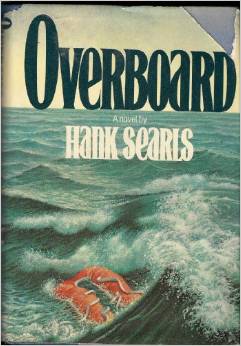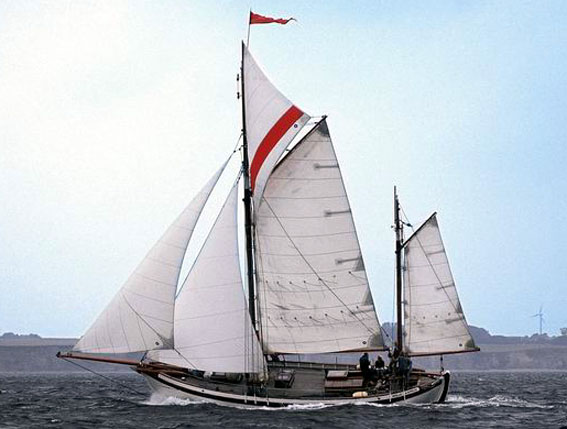Overboard by Hank Searls
This is one of several cover designs for this book, written in 1977. Much of the non-sailing information in the book is dated badly. The protagonist is a lawyer who wins a medical malpractice judgement of $1.5 million, “The largest judgement in California history.” Obviously that is dated.
The novel opens when the wife falls overboard. She gets up to check for traffic in the night and does not fasten her safety belt although she knows she must. A simple moment of carelessness and she is in the water. They are between Tahiti and Bora Bora in the Society Islands. They have been cruising for months. The backstory is told in flash backs.
Mitch the husband is a sailor who navigates for her father, a racing skipper who is getting old and is too competitive for Mitch. Mitch was a pre-med student in college who switched to pre-law and graduated from Boalt Hall, the UC law school. Lindy, his wife, did not finish college as she became pregnant with their oldest child at age 18. The two children are rather aimless in the way many college age children were in the early 70s.
Mitch is sailing with her father on San Francisco Bay, the author is rather contemptuous of racing, when he sees a Colin Archer ketch crossing the race course and nearly colliding with them as her father refuses to give way to the right-of-way boat until Mitch forces the helm over. He is entranced with this beautiful cruising ketch and spends considerable time searching for it and the owner.
A Colin Archer ketch under full sail.
As a racer myself, I am not enamored of Colin Archer designs as they are very slow sailers. San Francisco with its 25 knot afternoon breeze, would be a good place for one. Mitch searches for the ketch and, finally, Lindy’s father Shawn tells Mitch he knows where the boat is in a yard in Sausalito. Mitch goes to the yard and finds the owner, a salty old boatbuilder who looks like he has lost weight, possible due to illness, and who is very reluctant to sell. The discussion of what a buyer should look for and how a builder might feel about his boat are all authentic. The discussion ends with a tentative decision to sell.
Mitch is a trial lawyer and is suing a young doctor in a case where the patient suffered catastrophic injury but the doctor may not have been at fault. He is tortured by his conscience as his father was a surgeon (as was Searls’ father) and he dreads the censure of other doctors. The malpractice crisis was just arriving as this book was published. He wins the case but decides to quit and go cruising with his new boat. His wife is a reluctant first mate but is gamely enthusiastic.
The story alternates flashbacks with the present crisis of the wife overboard. Part of the story is told from her point of view in the water and part from his point of view as he searches desperately for her. There is an undercurrent that she was not enthusiastic about going cruising and she has had a probable affair with a fictional character who is obviously Bernard Moitessier, a famous yachtsman who circumnavigated several times, most notably in a single handed round the world race which he was leading near the finish when he decided to quit and sail to the south Pacific instead of to the finish in England.
The author, who lived aboard his own yacht for many years, has many novels to his credit and many movies including Jaws2. Searls also wrote the novelizations for the films Jaws 2 (1978) starring Roy Scheider and Murray Hamilton and Jaws: The Revenge (1987) starring Michael Caine and Lorraine Gary.
His meticulous research is famous among writers. Born in 1922, he is too old to be living aboard although he was when he wrote “Overboard.” In 1988, he was ashore, probably for good.
The couple now share a cozy, two-bedroom condo overlooking a golf course in Newport Beach. One bedroom serves as Searls’s office, and there he begins work each day shortly after 6:30 a.m. A nearby garage holds cartons of research materials, and a rented storage room several miles away contains 700 cubic feet of carefully labeled files—enough for “five different novelists,” he says. Although Searls is “easy to live with,” says Bunny, “he’s always researching, even if we go away on vacation.”
The story is authentic in every respect I can find and I have been sailing since the 1950s. I even gave serious thought to taking six months off from my medical practice to go cruising in the late 1970s, about the same time as this story. The story is a bit of a downer compared to “Trustee from the Toolroom” but the details of sailing are excellent and the story is very plausible, which “Trustee” lacks a bit. A view of the movie I made of the 1981 Transpac will show that we were almost completely negligent in the matter of safety harnesses but we were a full crew. A single or double handed boat crew at night is almost suicidally careless to ignore safety gear. When we were in heavy weather, we always wore safety harnesses. In a small hurricane in 1977 off Mexico, we spent the night in swim trunks and safety harnesses with the wind at 60 knots plus like a hot shower.
The book is an authentic tale of sailing in the days before satellite telephones and GPS.


Who cares about foreign policy? US is what counts.
Race realism that really counts. Why white males will become the laughingstock biological slaves of the black race.
Liberals say evolution made all races the same, and conservatives say God created all races the same, but race realism shows that while white men are smarter-nerdier than black males–just like Asian males are nerdier than white males–, black men totally whup white boy ass in athletics and sexual prowess that really turns on women.
[Spam link deleted by Jonathan.]
Clean-up, aisle 1. Not only a troll, but one without any pretense of attention to the topic.
G*d, I am sick of these comment-bots. Die, ye spawn of Satan – die, already!
Actually, sailboat sailing and racing are mostly white avocations but I have known a few black sailors and even a black sailmaker. There are plenty of black sailors in the Caribbean where sailing and fishing are interrelated.
Sailing is a reduction of the accoutrements of civilization until they are minimal. Camping is similar but is also becoming rare with the proliferation of cellphones, etc. The next review I want to write is of the grand daddy of them all, Joshua Slocum, who was a wonderful writer as well as sailor and captain.
Having been caught on the leading edge of a hurricane once on the Florida coast, I cannot imagine being on the water in one, especially in a small boat. Sounds like a nightmare. I’m somewhat amazed you survived it.
Dr. what do you make of the (what I see as the) conundrum at the highest end of sailboat racing; where boats are sail-powered to 40 plus MPH but can’t withstand much (if any) foul weather?
I have lost interest in the top end of sailboat racing. The America’s Cup, that I went to Australia to watch in 1987, is a bore now that it involves these delicate monsters that cannot go out if the wind is too strong and which require professional crews. Even lower down the money scale, the crews in big race events do not want to stay out over even one night. They want a hot shower and a gourmet dinner after the race. My son did a lot of crewing in that class. The owner would fly the crew from California or, wherever, to Florida for a week. Everybody was warm and dry and full of booze and food by 8 PM when most of my racing experience would be just settling in for the first watch of the night.
In 1987, the last year I cared, the Cup was contested in Fremantle where every afternoon the “Fremantle Doctor” comes in with wind at 30 to 40 knots. I knew a nurse who grew up in Freemantle (and who has returned I believe). When she was a girl, they would go to the beach in summer in the morning and, when “The Doctor” came in, they would pack up and go home. The wind was so strong that blankets and umbrellas would blow away and the air was full of sand. Freemantle is the little port town for Perth, which looks just like San Diego except it is on a river, not its own bay. We would board a 150 foot boat built to be a ferry to Rottnest Island off the coast after the Cup was over. We would see green water go over that 150 footer during the race. Our boat followed the race just outside the course markers and it was a great view.
Dennis Conner and the US team practiced in Hawaii as it was about the only place with equivalent conditions. Great racing in strong breeze. The present day monsters would not last 5 minutes. In those days the crews were still mostly amateurs. I had a chance to get my 20 year old son into a crew but he decided not to go for six months which would have been the deal. He would have begun as a bottom sander and worked up to a practice crew spot. It would have been a fantastic experience,
The hurricane we were in was a small one, called a “Chubasco” in Mexico. The Wiki article makes much about rain but ours was almost all wind and it pegged our wind speed at 60 for 12 hours. My boat was 38 feet and very strongly constructed (too heavy for present day racing) which was a good thing. After the storm, I found that the seas had taken all the bottom paint off the boat and during the storm the PVC tube that carried the electrical wiring inside the mast popped its rivets and fell the four feet to the mast step pulling all the wires out of the masthead.
We were still sailing with a #4 jib and no main but never had to heave to as most of the other boats did. The seas were huge, about the height of the spreaders on the mast. When we were in a trough, the boat stood upright as the wind was shadowed. When we rose to the peak of the sea, we would heel over about 45 degrees. There was at the time almost no weather forecasting in Mexico so we had no warning. Our warning was when we were sailing along with the wind behind us flying a spinnaker in mild conditions and then we saw the swell reverse and come at us from downwind ! The wind changed about two hours later.
We got on the radio and everybody was talking about it. The Mexican fishing boats had all gone to harbor. We knew we were in for it. We were about 30 miles offshore and about 40 miles north of Cabo San Lucas. It was early November and supposed to be after hurricane season but that was a small late one. Mexico gets big bad ones and I would not want to be in one of those.